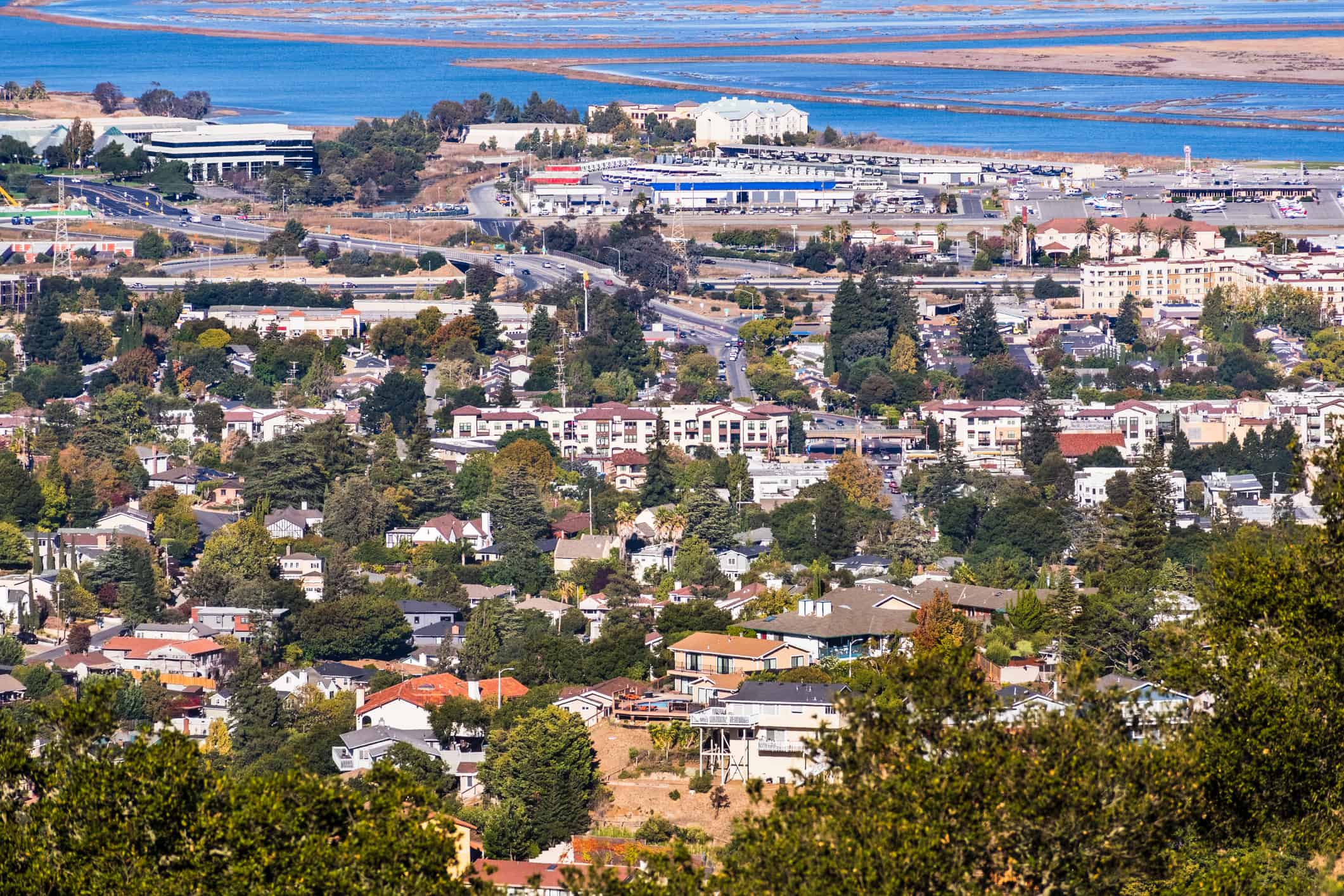
Famous view of California Street near China Town and the Financial District, with Chinese pagoda towers and the Bay Bridge at sunset in San Francisco.
©SvetlanaSF/Shutterstock.com
California is a beautiful state to live in. It’s a state that benefited greatly from the Gold Rush and the explosion of the film and entertainment industry. Not to mention the many sports teams in Southern and Northern California. Yet, California is the state that pays the most taxes in the United States… and by a large margin. The table below has data from the IRS on America’s gross collections and tax types in the 2022 fiscal year.
| Individual Income Tax Withheld And FICA Tax [3] | Individual Income Tax Payments And SECA Tax [3] | Unemployment Insurance Tax | Railroad Retirement tax | Estate And Trust Income Tax [4] | Estate Tax | Gift Tax | Excise Taxes [5] | Business Income Taxes [2] |
| 427,216,972 | 174,510,813 | 849,338 | 8,073 | 6,075,435 | 5,778,261 | 669,690 | 4,356,015 | 77,361,863 |
California’s Taxes Versus Other States
If one compares Cali’s metrics to the other states, California‘s gross collections blow every other state out of the water. The only states that are relatively close to Cali’s amounts are New York and Texas. There have been ongoing debates from financial analysts about which state has more taxes between Texas and Cali.
The CATO Institute has a fantastic article that presents both sides to the argument on which state has higher taxes. California has a higher sales tax than Texas. The Sales Tax Handbook reported that Cali’s local and state sales tax ranges from 7.25% to 10.75%. As for Texas, their sales tax range from 6.25% to 8.25%. Cigarette taxes in Cali doubles the amount of Texas’s cigarette tax and their gasoline tax is higher.
New York’s Business Income Tax is at forty-two million. Which is over thirty-five million less than California. Los Angeles’s marginal income tax rate is at 12.3% while New York City’s marginal income tax rate is at 10.9%. California across all the different tax categories are higher than every other state.
What Causes California To Have These Taxes?
Celebrities. Yes. You read that right. Celebrities. It’s home to the film and entertainment industry. The number of celebrities that live in California is endless. Some of the celebrities that live in California are LeBron James, the Kardashian family, Tyler The Creator, and so on. California gets most of its revenue from income taxes.
Cal Matters covered Cali’s tax years from 2015 to 2020. California raised $419 billion dollars for state and local services from taxes, fees, and federal funding, according to the US Census Bureau. Health and education services dominated the spending in that five-year span. Another reason that taxes have gone up was due to the voters extending the income tax increase for twelve more years in 2016. California’s income taxes are five times more volatile than personal income taxes due to several factors. The state taxes capital gains, dividends, partnership income, interests, and rent- those are areas where the highest-income people get most of their money from.
Thanks to the large number of celebrities that live in the Golden State, half of California’s personal income taxes come from people who make more than $500,000 annually.
Silicon Valley’s Impact

Elevated view of a residential district of San Francisco as seen from Twin Peaks at sunset in autumn. The Golden Gate Bridge and the bay are in the background. California, USA.
©AlbertPego/iStock via Getty Images
In the past decade, the technology industry has grown tremendously. The technology sector also plays into California’s tax volatility. In 2015, the Legislative Analyst reported that the nine counties that make up the San Francisco Bay Area contribute forty percent of personal income taxes- but are only home to twenty percent of Cali’s total population.
San Francisco’s reputation as one of the world’s main hubs for technology has threatened the dominance of Silicon Valley. According to the Financial Times, Foreign Direct Investments (FDI) in new tech projects in San Francisco slumped to an all-time low since 2009. The high taxes in San Francisco also threaten the presence of Silicon Valley and its ability to be attractive to international investors in the tech sector. Not only that, San Francisco is the second-highest United States city in office rent, which plays a factor in the decision-making for international investors.
How Does The State’s Tax Revenue System Affect Those With Different Incomes?
The California Budget & Policy Center covered the state’s tax revenue system. Kayla Kitson, who wrote the article covering the state’s tax revenue system stated that “Californians with higher incomes pay a larger percentage of their income in personal income taxes than people with lower incomes because higher portions of income are subject to higher tax rates”.
In return, the sales and excise tax affects those with lower incomes more than those with higher incomes. The sales tax on common goods takes up more shares of their income since they need to cover the common goods. The sales and use tax is the second largest revenue source. Excise tax, which taxes gasoline, alcohol, and various tobacco products also affects California residents with lower incomes. The twenty percent of California families with the lowest incomes pay 7.4% of their total income in local and state excise and sales taxes, compared to the 0.8% for the top 1% in the highest income.
The Residential Property Tax
Residential houses drive up to seventy percent of property tax revenue. Housing is also more expensive than before, especially considering the rising costs of inflation. California has the highest impact fees in the construction of a single-family home at $23,455, per CalMatters. In recent years, local governments increased their usage of the Mello-Roos assessments to pay for new infrastructure. Usually, that’s a cost that’s passed onto new housebuyers.
What is the Mello Roos? It’s a special tax district that uses money to finance the roads, water and sewage systems, to even the street lights in their respective areas. These things are a driving point to the cost of homes. The effects of these taxes also make housing unaffordable for potential homeowners between the ages of 24-35.
CalMatters data reporter Matt Levin states: “In 1969, the median sales price of a California house was about $166,000 in today’s dollars. That was about three times the median average income ($55,400) of younger California families at the time who might be in the market for a starter home. Today, the average California home sells for over $500,000. That is seven times higher than a younger family’s earnings.
Summary
California pays the most federal taxes in the United States, but why? The simple answer would be that celebrities live in California. They’re rich, obviously. Thanks to the large number of celebrities that live in the Golden State, half of California’s personal income taxes come from people who make more than $500,000 annually.
But that isn’t the only reason. The Bay Area’s booming technology job industry created many people who fall along the median annual income of more than $500,000. It got to the point where the San Francisco Bay Area contributes forty percent of personal income taxes- but is only home to twenty percent of Cali’s total population.
The state tax revenue system works to an extent where it taxes the rich more than the poor on their capital gains. However, it also taxes the poor based on their sales and excise taxes much more than what the lower-income families may think. So, the twenty percent of California families with the lowest incomes pay 7.4% of their total income in local and state excise and sales taxes. The top 1% in the highest income bracket in California only pays 0.8% of their total income in local and state excise and sales taxes.
Thank you for reading! Have some feedback for us? Contact the AZ Animals editorial team.








